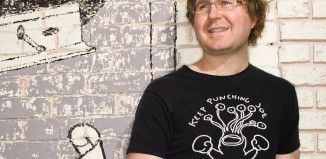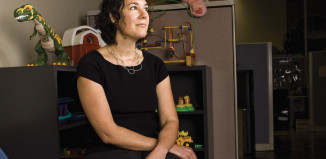It’s a drizzly morning in late January, and the streets of downtown Austin are unusually quiet for a Monday. The Martin Luther King Jr. holiday has kept many Austinites at home on this damp and dreary morning. But in a third-floor office overlooking Fifth Street and Congress Avenue, it’s a very different world.
Phones ring across corridors as workers twitter about from cubicle to cubicle, dancing through the hallways, careful not to step on piles of posters recently removed from the walls or bump into furniture resting askew from its usual position. It’s an enterprising ballet of sorts that will soon culminate in a mass exodus from the building. This is moving week at the offices of the Long Center.
A community-wide project that has been in the works for more than a decade, the Joe R. and Teresa Lozano Long Center for the Performing Arts is finally becoming a reality. Opening in March in the renovated space that was once Palmer Auditorium, the Long Center will act as Austin’s go-to venue for the performing arts, with programming to include everything from Austin Symphony Orchestra, Austin Lyric Opera and Ballet Austin performances to more avant-garde and non-traditional shows featuring music, theater and comedy, and everything in between.
As the Long Center employees feverishly box up their workspaces, preparing to make the move from their downtown offices to the breathtaking new Long Center structure near Town Lake, they are somewhat overwhelmed by the endeavor, if not energized by what the future holds for them, the arts sector, and indeed, the entire city of Austin.
 “Everybody here is very excited to just get the doors open after all this time and start changing the way the world views the Austin arts scene,” says Cliff Redd, executive director of the Long Center. “This project is one that will vastly differentiate itself from other performing arts centers across the country. The Long Center looks like Austin, was built in the methodology that is right for us, and at a wonderful value. It’s a beautiful venue that everyone in Austin should be very proud of.”
“Everybody here is very excited to just get the doors open after all this time and start changing the way the world views the Austin arts scene,” says Cliff Redd, executive director of the Long Center. “This project is one that will vastly differentiate itself from other performing arts centers across the country. The Long Center looks like Austin, was built in the methodology that is right for us, and at a wonderful value. It’s a beautiful venue that everyone in Austin should be very proud of.”
And when Redd says he wants everyone in Austin to be part of the Long Center, he literally means everyone in Austin. Structured to be an all-inclusive community venue, the Long Center is at its heart a place of learning, enrichment and culture. Its mission is to reach all kinds of people, bettering their lives through art and opening their minds to new and profound experiences.
“From the beginning, it’s been very important to the Long Center to be diverse in our programming. We were trying to solve a problem: We needed an arts venue for the symphony, opera and ballet, but it wasn’t enough to wind up there,” Redd says. “We wanted to have that amazing, out-of-the-box dance company performing the same night as the symphony, and have those audiences come together – whether in the common areas during intermission, or walking to their cars after a performance – and share their experiences. We believe that the symphony, opera and ballet will benefit from this idea. Their audiences with change and grow too.”
The challenge of creating a performing arts venue that values diversity in its programming and its audience is what drew Redd to the Long Center project. A veteran arts leader, fundraiser and theater professional who grew up in the Austin area, Redd is a fitting representative for the Long Center, and shares the goals of the center’s trustees and donors, but also has strived to establish a world-class performing arts center that the public will embrace.
With Redd at the helm, the Long Center successfully raised in excess of $77 million from more than 4,000 local donors, an achievement that Redd says reflects Austin’s wealth of support for the project. And though the initial plans for the Long Center called for a more ambitious $110 million facility that was scaled back thanks to a slowing economy, a cleaner, more elegant design emerged, allowing for 97 percent of the existing Palmer Auditorium to be re-used.
The transformed structure now boasts the Michael & Susan Dell Hall, a breathtaking 2,400-seat grand concert hall; the Debra & Kevin Rollins Studio Theatre, a flexible space for regional and community art performances and film screenings; and a 30,000- square-foot terrace with stunning views of downtown Austin. A future construction phase will add a recital and rehearsal hall and the Topfer Theatre. The end result translates to Austin’s first authentic community performing arts venue.
“Everyone in Austin needs to be here. Whatever you’re wearing, whoever you are, if the Long Center doesn’t mean something to you, we’re doing something wrong,” Redd asserts.
Austin’s gay and lesbian community, which has contributed generously to the creation of the Long Center (“Our names are all over the founders’ wall,” Redd beams.), will play its part in helping to nurture the venue. Many gay-centric shows and performances will grace the programming schedule and Redd says he hopes to see the Long Center serve as a home for large-scale gay and lesbian community events.
“The essence of what the Long Center is about is inclusion. And, of course, we want the gay and lesbian community involved in the Long Center,” Redd maintains. “We want everyone in Austin to feel a sense of ownership for this place. And we want everyone in Austin to be involved in the project and of equal value.”
Truly an Austin-centric project, the Long Center is a venue, Redd says, that should mirror the best of Austin, both during its initial opening and throughout the course of its life. “This place needs to be constantly reflexive of what we hold so dear in our community,” he says. “It’s my job to have it live and operate that way. As for the gay community, as with every community in Austin, we want to be able to create events of gathering that reach people they might not reach otherwise. We can provide a crossover between the gay and lesbian community and others. If we’re thoughtful about how we can galvanize various communities and if we’re thoughtful about the venues in which we bring each other together to discuss and enjoy the arts, the log- ical place to do that is the Long Center.”
The Long Center will spend the entire month of March celebrating its opening, with programming ranging from spectacular musical performances to mesmerizing ballet, poetry slam and choreographed shows that will no doubt dazzle and delight audiences. Additionally, Austin theater collective Rude Mechanicals will premiere its much-anticipated show, “The Method Gun” in April at the Long Center.
It’s a production Redd says he’s very much looking forward to, in part, because the show will help attract gay and open-minded crowds to the Long Center from its inception.
“The gay and lesbian community has been very supportive of the Long Center, and we wear that badge proudly,” Redd says. “So to the gay community I say: We’re glad you’re here, and we’re going to do everything we can to support you.”




































